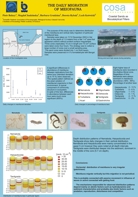

In contrast to the wave-swept surface sand inhabited by most of the macrofauna, the interstitial system is truly three-dimensional, often having great vertical extent in the sand. The porous system averages about 40% of the total sediment volume. Its inhabitants include small metazoans forming the meiofauna, protozoans, bacteria and diatoms (Brown & McLachlan 1990). The meiofauna is defined as those metazoan animals passing undamaged though 0.5 to 1.0 mm sieves and trapped on 30 ?m screens. On most beaches the interstitial fauna is rich and diverse, even exceeding the macrofauna in biomas in some cases (Brown & McLachlan 1990). The dominant taxa of sandy beach meiofauna are nematodes and harpacticoid copepod with other important groups including turbellarians, oligochaetes, gastrotrichs, ostracods and tardigdades.




 The
daily migration of meiofauna (poster).
The
daily migration of meiofauna (poster).